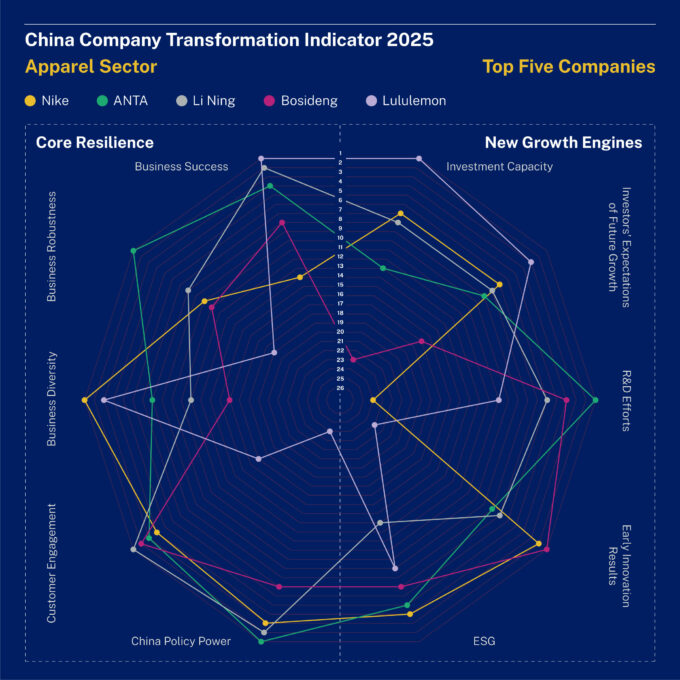
test 100
Uncategorized test 100 Published May 8, 2025 in Uncategorized • 1 min read DownloadSave Uncategorized test 100 Published May 8, 2025 in Uncategorized • 1 min read DownloadSave Lorem ipsum dolor sit...

by Mark J. Greeven, Sophie Liu Published April 14, 2025 in Asian hub • 6 min read
The 2025 IMD China Company Transformation Indicator (CCTI) rankings highlight three key success factors for leading apparel companies: Business Robustness (BR), Early Innovation Results (EI), and R&D Efforts (RD). The top performers demonstrated financial strength, a strong commitment to product innovation, and adaptability to changing consumer needs. However, challenges remain; trading conditions are tough, and domestic brands still lag behind global peers in ESG practices, which is a concern, as these are becoming increasingly important to Chinese consumers.
Strong momentum in 2023, which saw total retail sales of the entire Chinese garments, footwear, hats, and textiles sector grow 12.9% year-on-year to RMB 1.4tn, signaled a growing consumer enthusiasm for apparel. The sportswear and ‘athleisure’ segment led this 2023 growth, propelled by increasing health consciousness and large-scale sporting events. Government initiatives like the Outdoor Sports Industry Development Plan (2022-2025) have played a crucial role in supporting this trend.
However, this momentum virtually ground to a halt in 2024 amid both external and domestic economic challenges. As sluggish global growth, rising geopolitical tensions, and China’s internal restructuring combined with weak consumer demand and slower income growth, the mass market was hit particularly hard, even as premium segments showed relative resilience.
The government responded with stimulus measures following a high-level meeting in late September 2024, giving companies yet another prompt to drive growth through innovation. Early signs of recovery began to emerge in early 2025, and with continued policy support, the market is expected to gradually regain momentum, building on the foundation established during the stronger 2023 performance.
While Nike continues to lead the sector, local champions including ANTA and Bosideng now dominate the market with multi-brand strategies, advanced materials, and strong digital customer engagement. Meanwhile, international brands like Canada-based Lululemon demonstrate that foreign companies can succeed by adapting to Chinese consumer preferences, as evidenced by the company’s significant jump in the rankings.
Unlike some competitors who rely on a single-brand identity, ANTA has successfully captured a larger market share through a diversified portfolio, including premium international labels.
A full description of each key factor is in the methodology section of the white paper.

ANTA Sports claimed the second-ranked spot in the 2025 rankings, continuing to dominate China’s sportswear industry with its multi-brand strategy and vertical integration model. Unlike some competitors who rely on a single-brand identity, ANTA has successfully captured a larger market share through a diversified portfolio, including premium international labels like FILA, DESCENTE, and KOLON SPORT. This approach enables ANTA to serve diverse consumer segments ranging from mass-market sportswear to high-end performance gear.
ANTA’s top ranking in Business Robustness reflects its exceptional financial resilience. In 2023, revenue surged 16.2% to RMB 62.4bn, with the ANTA brand generating RMB 30.3bn and FILA contributing RMB 25.1bn. This momentum continued into the first half of 2024, with revenue growing 13.8% to RMB 33.735bn. The company’s leading position in R&D Efforts stems from its increased investment (up 6.2% to RMB 1.61bn in FY2023), resulting in developments in high-performance footwear, smart sportswear, and the use of eco-friendly materials. With more than 2,300 patents, ANTA demonstrates a long-term commitment to differentiation through the innovative application of technology.
Bosideng has transformed from a mass-market brand into China’s undisputed leader in premium down apparel. Its top ranking in Customer Engagement highlights strong consumer loyalty and effective digital strategies, driven by a successful direct-to-consumer model. Full-year 2023/24 revenue surged to RMB 23.2bn (up 38.4% year-on-year), with net profit rising 43.8% to RMB 3.1bn and gross margin up at 59.6%.
Bosideng’s commitment to R&D-driven differentiation is reflected in its fourth-place ranking in R&D Efforts, with 545 patent applications during the year 2023/24, 222 new patents filed, and 340 patents granted in the first half of 2024/25, totaling 1,193 patents by September 2024. These innovations include thermal insulation, lightweight materials, and innovative construction techniques, which all contribute to reinforcing Bosideng’s technical leadership in down apparel.
Lululemon Athletica made the biggest ranking jump, rising from ninth place in 2024 to fifth place in 2025, signaling strong momentum in China’s premium activewear market. Ranked first in Investors’ Expectations of Future Growth, Canada’s Lululemon reported full-year 2023 revenue of $9.6bn (19% year-over-year increase), with China alone growing 67%. In Q3 2024, international revenue jumped 33%, reinforcing its strong growth trend in Asia-Pacific markets.
With a goal of doubling revenue to $12.5bn by 2026 (15% CAGR between 2021 and 2026), Lululemon has positioned itself as a major contender in China’s premium sportswear space. However, the brand ranked low in R&D Efforts, highlighting a key area for improvement. Enhanced investment in technical performance fabrics, AI-driven personalization, and smart apparel technologies could further elevate its competitiveness.
Adidas dropped from fourth in 2024 to eighth place in 2025. While maintaining leadership in sustainability and responsible business practices, its decline in Customer Engagement from fourth to sixth place in just one year suggests growing pressure on its ability to build connections with Chinese consumers. With domestic competition intensifying, Adidas must recalibrate its brand positioning and engagement strategies to remain competitive in China’s dynamic market.

The future belongs to companies that master innovation, deepen local engagement, and embed sustainability into their core strategies.
China’s apparel sector – particularly sportswear – continues to show remarkable resilience despite economic and geopolitical challenges. The CCTI 2025 rankings confirm a clear industry shift toward innovation, financial resilience, and consumer-centric strategies. However, brands must address growing market fragmentation, intensifying competition, and rising consumer expectations to maintain momentum.
While domestic brands gain ground, they also need to develop stronger market positioning and differentiation.
Simultaneously, evolving consumer demands require companies to strengthen digital engagement, localize production innovation, and consider international expansion. Though financial performance remains strong, striving for sustainability and ESG excellence presents a key opportunity for long-term leadership.
Discover the full results of the IMD China Company Transformation Indicator 2025.

Professor of Management Innovation, Dean of IMD Asia, Chief Executive of IMD China
Mark Greeven is Professor of Management Innovation and Strategy and Dean of Asia at IMD, where he co-directs the Building Digital Ecosystems program and the Strategy for Future Readiness program. Drawing on two decades of experience in research, teaching, and consulting in China, he explores how to organize innovation in a turbulent world. Greeven is responsible for the school’s activities and outreach across China and is a founding member of the Business Ecosystem Alliance. He is ranked on the 2023 Thinkers50 list of global management thinkers.

Research Associate, IMD China
Sophie Liu is a Research Associate at IMD China. Her work focuses on business and company transformation within China’s dynamic market landscape, as well as the development of Generative AI in the region, with a particular emphasis on the Asian market. Sophie holds a Master of Science in Finance from the Chinese University of Hong Kong and a Bachelor’s degree in engineering from the National University of Singapore. Prior to joining IMD, she gained valuable experience in equity investment in Hong Kong and the banking industry in Singapore, bringing a well-rounded perspective to her research.

10 mins ago • by Sarah E. Toms in Asian hub
Uncategorized test 100 Published May 8, 2025 in Uncategorized • 1 min read DownloadSave Uncategorized test 100 Published May 8, 2025 in Uncategorized • 1 min read DownloadSave Lorem ipsum dolor sit...

April 14, 2025 • by Mark J. Greeven, Sophie Liu in Asian hub
China's technology industry is driving global innovation by integrating AI, expanding ecosystems, and developing semiconductors. Despite legislative changes and trade tensions, firms who engage in R&D and diversify their business models gain...

April 14, 2025 • by Mark J. Greeven, Sophie Liu in Asian hub
China’s pharmaceutical sector is undergoing a major transformation, driven by innovation, demographic shifts, and bold regulatory reforms. As urbanization and an aging population fuel demand, top companies are leveraging R&D strength and...

July 18, 2024 • by Mark J. Greeven, Sophie Liu in Asian hub
The New Materials sector in China is currently dominated by foreign multinational companies, but the Chinese government’s strategic focus on the sector is encouraging home-grown challengers to invest in research and development...
Explore first person business intelligence from top minds curated for a global executive audience